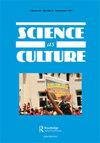欧洲核子研究中心科学与欧洲的纠缠:一种共同生产关系的时间动力学
IF 2.4
3区 哲学
Q1 CULTURAL STUDIES
引用次数: 3
摘要
欧洲核子研究组织(CERN)是欧洲历史最悠久、规模最大、最具代表性的研究基础设施之一。它的历史,通过其自身组织身份的叙述来表达,不仅反映了其技术科学活动的发展,而且强烈地参考了欧洲的多种表现。通过分析近七十年来组织身份的这些叙述,可以观察到技术科学和社会政治秩序之间持续的共生关系-更具体地说,是粒子物理学和欧洲之间的关系。此外,这些命令之间的正当性和解释性关系也发生了相当大的变化。在最初的三十年里,欧洲核子研究中心被设想为一个可以通过科学实现欧洲统一的组织。科学作为一种欧洲共同语言的广阔视野促成了战后欧洲通过其文化/科学根源(重新)统一的想象。然而,大约从1990年开始,欧洲核子研究中心就一直把自己描绘成“世界实验室”,从而构建了一种新的欧洲想象,将其作为支持全球粒子物理学的组织和文化资源。因此,出现了一种叙事上的转变,从通过科学促进欧洲合作,到通过特定的欧洲理念促进世界范围内的科学发展。研究这些共同生产关系的时间动态使我们对社会政治和技术科学秩序之间平衡的转变敏感:它揭示了哪些秩序被叙述为驱动因素,哪些被驱动因素,以及这是如何打开或关闭正当叙述和行为方式的。本文章由计算机程序翻译,如有差异,请以英文原文为准。
On the Entanglement of Science and Europe at CERN: The Temporal Dynamics of a Coproductive Relationship
ABSTRACT The European Organization for Nuclear Research (CERN) is one of the oldest, largest, and most emblematic European research infrastructures. Its history, as expressed through narratives of its own organizational identity, does not only reflect the development of its technoscientific activities but also strongly references a multiplicity of performances of Europe. By analysing these narratives of organizational identity over nearly seven decades, it is possible to observe an ongoing coproductive relationship between technoscientific and sociopolitical orders—more specifically between particle physics and Europe. Furthermore, there has been a considerable shift in the justificatory and explanatory relationship between these orders. In its first three decades, CERN was envisioned as an organization in which European unity could be accomplished through science. A broad vision of science as a common European language contributed to an imaginary of postwar Europe (re-)united through its cultural/scientific roots. Roughly since 1990, however, CERN has been presenting itself as a ‘laboratory for the world’, thereby constructing a new imaginary of Europeanness as an organizational and cultural resource to support global particle physics. Thus, there has been a narrative shift from European collaboration being promoted through science, to science on a world scale being promoted by a specific idea of Europeanness. Studying the temporal dynamics of coproductive relationships like these sensitizes us to shifts of balance between sociopolitical and technoscientific orders: it reveals which orders are narrated as drivers and which as driven as well as how this opens up or closes down justificatory narratives and ways of acting.
求助全文
通过发布文献求助,成功后即可免费获取论文全文。
去求助
来源期刊

Science As Culture
Multiple-
CiteScore
5.20
自引率
3.80%
发文量
28
期刊介绍:
Our culture is a scientific one, defining what is natural and what is rational. Its values can be seen in what are sought out as facts and made as artefacts, what are designed as processes and products, and what are forged as weapons and filmed as wonders. In our daily experience, power is exercised through expertise, e.g. in science, technology and medicine. Science as Culture explores how all these shape the values which contend for influence over the wider society. Science mediates our cultural experience. It increasingly defines what it is to be a person, through genetics, medicine and information technology. Its values get embodied and naturalized in concepts, techniques, research priorities, gadgets and advertising. Many films, artworks and novels express popular concerns about these developments. In a society where icons of progress are drawn from science, technology and medicine, they are either celebrated or demonised. Often their progress is feared as ’unnatural’, while their critics are labelled ’irrational’. Public concerns are rebuffed by ostensibly value-neutral experts and positivist polemics. Yet the culture of science is open to study like any other culture. Cultural studies analyses the role of expertise throughout society. Many journals address the history, philosophy and social studies of science, its popularisation, and the public understanding of society.
 求助内容:
求助内容: 应助结果提醒方式:
应助结果提醒方式:


